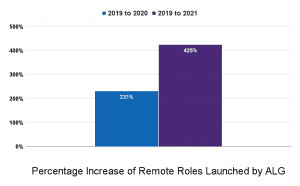Two things happened when the pandemic hit at the beginning of 2020. First, in a matter of just a few weeks, almost all of us were forced to change our notion of “workplace,” as office-based jobs shifted to online work. Second, nonprofit organizations had to continue managing staff, raising money, and even recruiting and hiring, all during a time when we didn’t know how long this disruption to our 2019 notion of workplace might last.
It turned out that the disruption lasted a lot longer than anyone expected, and it has created lasting changes in where we work and how organizations recruit. As but one illustration: pre-pandemic, the number of Aspen Leadership Group searches offering remote or location-flexible work averaged less than 5% of the total.

Today, such positions can represent anywhere from 25% to 50% of searches launched each month.
At this point, with two years of experience, we have all had an opportunity to develop new habits, approaches, and realizations about what “workplace” means to us individually. Employers and employees alike have a better idea of what it takes for teams to work together effectively, in person as well as remotely. And employers have seen how workplace flexibility can contribute to, or detract from, optimal functioning of the organization as a whole.
In our view, this kind of Great Rethink presents a huge opportunity to reimagine the notion of “workplace” in a positive, productive way. We believe it would be a mistake, now that the worst of the disruption seems to have passed, to reflexively shift back to the old way of doing things: by and large a one-size-fits-all approach that requires 8:30-to-5, in-office work for everyone. But we also believe it would be a mistake to respond to this new openness to remote work, and candidates’ desire to continue working remotely, by imposing new one-size-fits-all approaches, such as “everybody works from home two days a week.”
Instead, we have an opportunity we never expected: to evaluate the advantages and disadvantages of both in-person work and remote work. We can now create workplace models that meet more needs of employers and employees, more often, and are tailored to the work that needs to be accomplished. We believe that:
- both remote and in-person work can be attractive and highly productive;
- the advantages and disadvantages of remote work do not apply to every job, individual, team, or organization in the same way;
- flexible policies are required to create optimal performance;
- discussion is critical, as employers and employees learned a lot in the past couple of years and have a lot to learn from each other; and
- employers may need to try several different iterations of workplace policies before finding those that are best for a specific employee, team, and organization.
Employers now have more choices beyond “remote” or “non-remote,” with individual job requirements providing the best guide in choosing from an array of possibilities. It may be that some positions can be entirely remote, especially if there is a large travel component or a heavy schedule of external donor meetings and events. Some may be almost entirely remote but require the employee to be close enough that the office is accessible with just a few hours’ notice – i.e., you don’t have to get on a plane to get there if there is an urgent need. Some may be partially remote, but flexible as to which days are in-office days. Other positions – like vice presidents, executive directors, and other senior roles – may need to be almost entirely in the office, to be close to C-suite executives and other internal stakeholders as well as potentially large teams of direct reports.
Given the wide range of opportunity to create something new and unique to each organization, we believe the most important thing employers and job candidates can do right now is talk to each other. Such conversations should also be taking place within the organization with existing employees.
Based on these discussions, organizations may find that each team has its own unique mix of office-based and remote workers, and all remote workers may not all have the same at-home schedules. We believe they will surely find that “equal” treatment of workplace (i.e., everybody follows the same rules) does not necessarily guarantee the best or even “equitable” outcomes (i.e., a rigid policy may create benefits for some employees but hinder others from making their best contribution).
This is just the beginning of an exciting new era for philanthropy. We have discovered that a redefined workplace is not something to be feared. Rather, it can be leveraged as a powerful tool in support of an organization’s mission.
Let’s take the best from the two worlds we now know – remote and non-remote – and create better solutions than we’ve known before.
Curious to learn more? Read the next article in our series here.
Contributing author:

Ron Schiller, Founding Partner, Aspen Leadership Group


